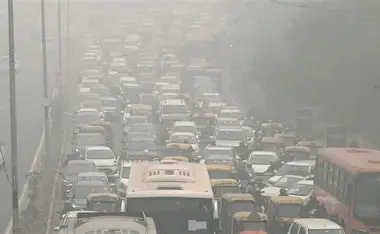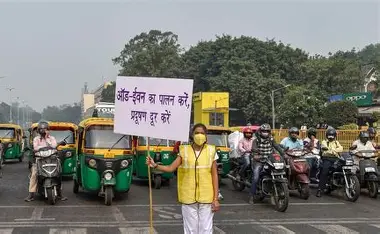Table of Contents
Introduction: Delhi’s Pollution Nightmare Returns
Every year as winter begins, Delhi’s air turns dangerous. The sky becomes grey, the air smells like smoke, and it becomes hard to breathe. This is not just a one-time event. It has become a pattern for India’s capital. With pollution levels rising beyond safe limits once again, the government is planning to reintroduce the odd-even rule for vehicles.
But the big question remains – Can the odd-even scheme really help this time? Or is it just a temporary trick to show action?
Let’s explore why Delhi keeps choking every year, what odd-even means, and if it can actually bring any real relief this time.
What Is Delhi’s Odd-Even Rule?
The odd-even rule is a traffic control method to reduce the number of vehicles on roads. It allows vehicles to move based on the last digit of their registration number:
- Vehicles with odd numbers can move on odd dates
- Vehicles with even numbers can move on even dates

The rule does not apply to emergency services, women drivers, and public transport. It is usually applied for a few days or weeks when pollution levels rise sharply.
Why Is Delhi So Polluted Every Year?
Pollution in Delhi is a result of multiple problems happening at the same time. Here are 7 shocking facts that show why the city suffers so much:
- Air Quality Index Crosses 400+
According to pollution control boards, Delhi’s Air Quality Index (AQI) regularly touches 400–500 in winter, which is considered “severe” and dangerous for health. - Stubble Burning in Punjab and Haryana
Farmers burn crop waste in nearby states during October–November. The smoke travels to Delhi and stays trapped due to cold winds. - Traffic Congestion and Vehicle Emissions
Over 1 crore registered vehicles run in Delhi. Cars, buses, and trucks produce harmful gases like nitrogen dioxide and carbon monoxide. - Construction Dust Everywhere
With non-stop construction work, huge amounts of dust rise and float in the air. This makes pollution even worse. - Firecrackers During Festivals
Despite bans, firecrackers are burst during Diwali, adding dangerous chemicals and smoke into the already polluted air. - Cold Weather Traps Polluted Air
In winter, warm air rises and cold air stays near the ground. This keeps pollutants trapped near the surface for days. - Low Use of Public Transport
Even with metro and buses, people prefer using their own vehicles. This puts more pressure on roads and the environment.
How Bad Is the Health Impact?
Doctors have warned that breathing Delhi’s air is equal to smoking 10–15 cigarettes a day during peak pollution days. Children, elderly people, and those with lung or heart problems are the most affected.
Common health problems include:
- Asthma attacks
- Breathing difficulty
- Burning eyes
- Constant coughing
- Fatigue and tiredness
- Even long-term damage to lungs
Hospitals often report a rise in patients with respiratory issues during October to January every year.
Is Odd-Even a Real Solution or Just a Show?
The odd-even scheme has been used before in Delhi. It first started in January 2016 and was repeated a few more times in later years. Each time, the government claimed some success, but experts gave mixed reviews.
Pros of the Odd-Even Rule:
- Temporary drop in traffic
- Slight improvement in AQI for a few days
- Increased public awareness about pollution
Cons of the Odd-Even Rule:
- Short-term effect only
- Public transport not strong enough to carry extra load
- Many exceptions make the rule weak
- Does not address the root causes like stubble burning or construction dust
According to an IIT Delhi study, odd-even may reduce pollution by only 4% to 6%, and that too if implemented strictly.
What Do People Say?
Public opinion about the odd-even scheme is divided:
- Some support it, saying that at least it’s something rather than doing nothing.
- Others call it a gimmick, saying it’s just a way to show action without real results.

Many complain about the lack of planning and confusion during its implementation. They also highlight the difficulty for working people who don’t have two vehicles or access to metro or buses.
What Can Actually Work Better?
To reduce pollution in Delhi, experts believe long-term measures are more important than temporary fixes. Here are some strong suggestions:
- Stop stubble burning with better machines and support for farmers
- Strict ban on construction dust and better dust control methods
- Improve public transport – more buses, cleaner metro, last-mile connectivity
- Switch to cleaner fuels and promote electric vehicles
- Stricter laws and real-time monitoring of factories and industries
- Increase green cover by planting trees
- Mass awareness campaigns to change public habits
What’s Next for Delhi?
As of now, the Delhi government has announced plans to bring back the odd-even rule if pollution continues to rise. Special teams have already started checking construction sites and vehicle emissions.
Schools have been closed during peak AQI days, and the Graded Response Action Plan (GRAP) is in place, which involves steps like stopping diesel generators, construction work, and truck entry.
But the real battle is much bigger than just stopping a few cars.
Conclusion: A Call for Real Action
Delhi’s pollution is not just a seasonal story anymore. It’s a public health emergency that returns every year without fail. While odd-even may offer a little help, it is not the solution Delhi truly needs.
What’s needed is a combined effort by governments, industries, farmers, and citizens. Only then can we hope to breathe clean air again.
The odd-even scheme might be a step in the right direction – but unless followed by bold and long-term actions, it will just be another temporary bandage on a growing wound.












Leave a comment